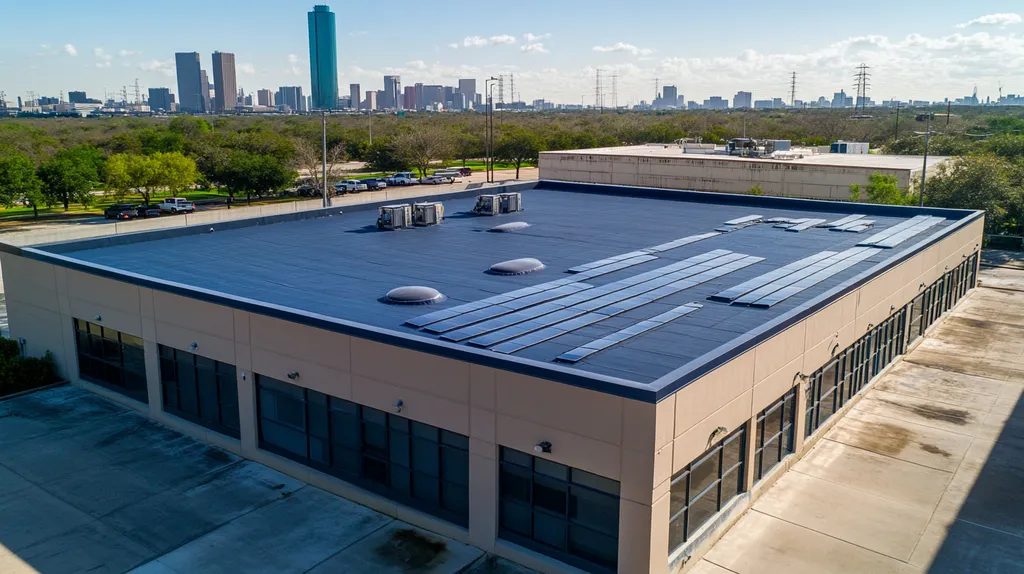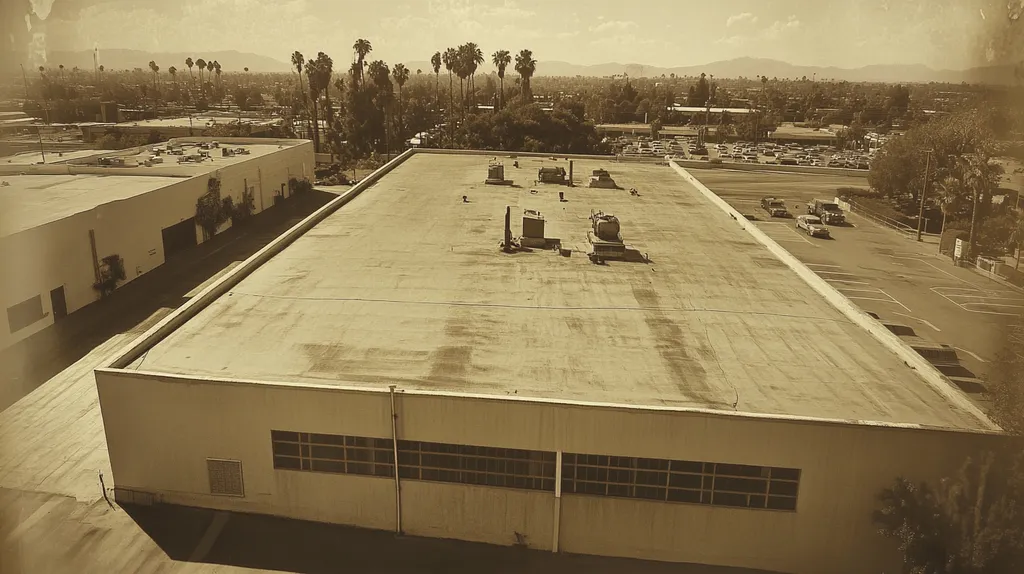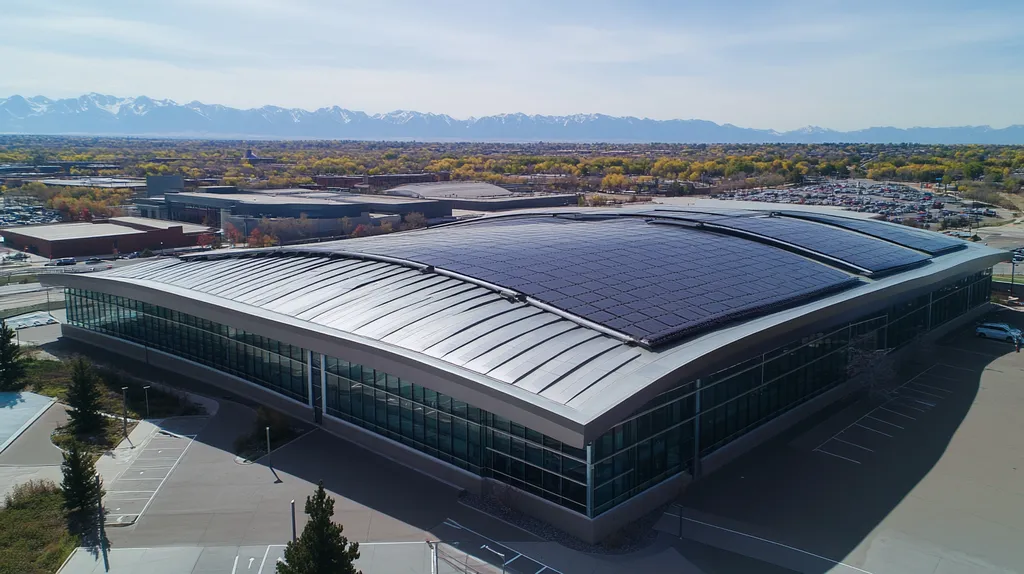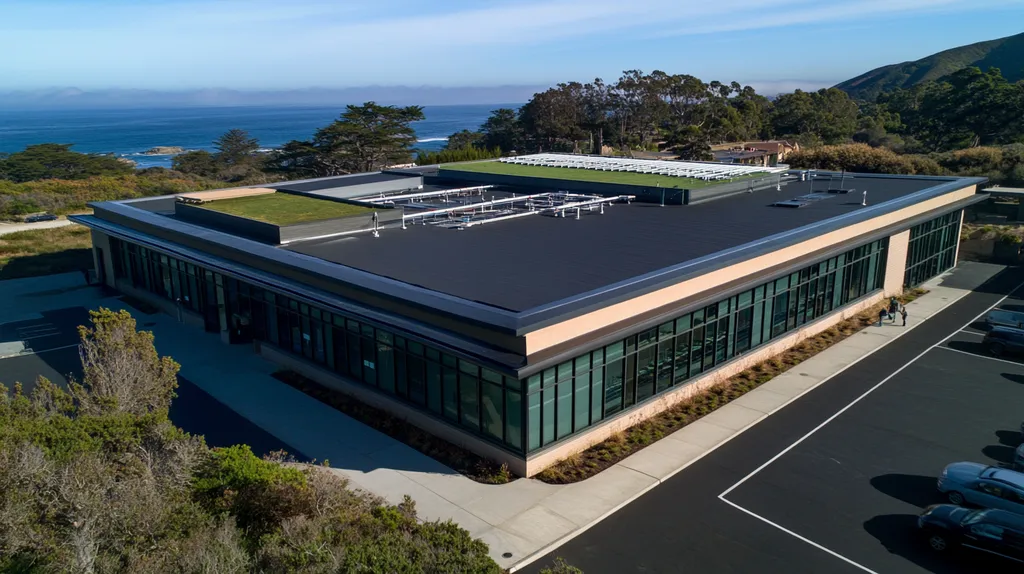Falls from poorly lit commercial roofs account for over 30% of workplace accidents, making proper illumination a critical safety imperative that many building owners overlook.
Integrated lighting systems, when properly designed and maintained, can reduce accident rates by up to 75% while simultaneously lowering insurance premiums and energy costs.
This comprehensive guide breaks down everything property owners and facility managers need to know about implementing effective rooftop lighting solutions – from basic concepts to practical applications and common challenges.
SECTION 1: THE BASICS EXPLAINED
When it comes to safety on commercial roofs, proper lighting is often overlooked, yet it plays a crucial role in preventing accidents. According to the Occupational Safety and Health Administration (OSHA), falls are the leading cause of fatalities on construction sites. By integrating effective lighting solutions into your roof design, you can significantly minimize these risks. This section will break down what integrated lighting is, why it is essential for your building’s safety, and how it operates to keep workers safe and secure.
What It Is (In Plain Language)
Integrated lighting is a specialized lighting system built right into the roofing structure. Unlike traditional lights that are installed later, these systems are designed to work harmoniously with the roof, ensuring that light shines exactly where it’s needed—over critical work zones and pathways.
Typically, these systems employ durable LED fixtures that are not only energy-efficient but also resistant to harsh weather conditions. Remote controls allow the lighting to be adjusted based on the time of day or specific activities, enhancing flexibility and safety.
Think of integrated lighting as an essential safety feature rather than a mere accessory. It seamlessly fits into the overall design of commercial roofs, providing clear visibility so that workers can easily identify hazards while conducting maintenance or inspections.
The result is a safer working environment, where integrated lighting becomes a powerful ally in the quest to keep everyone secure on the roof.
Why It Matters (To Your Building)
Safety should always be a top priority when managing commercial roofs, and integrated lighting is a key player in achieving this goal. Enhanced visibility helps workers spot potential slip hazards, equipment, or structural concerns more effectively. This improved lighting is vital for routine maintenance, as it allows for timely inspections.
Buildings lacking adequate lighting are at a higher risk of accidents, which can lead to increased insurance costs and potential legal consequences. By investing in integrated lighting, property owners can mitigate these financial risks while prioritizing worker safety.
Not only does effective lighting enhance overall safety, but it can also boost energy efficiency. Many integrated lighting systems utilize solar technology or energy-efficient LEDs, keeping utility bills low. This means property owners can tackle safety issues head-on while enjoying long-term financial benefits.
In addition, compliance with safety regulations becomes more straightforward with an integrated lighting system, which reduces risks and liabilities. This aspect is essential for responsible property management in any commercial setting.
How It Works
Integrated lighting systems rely on strategically positioned LED fixtures to illuminate essential roof areas. These lights can be connected to sensors that automatically adjust brightness based on real-time conditions. For example, when a worker is present on the roof, the lights can automatically brighten to ensure optimal visibility.
Furthermore, these systems can be integrated with your existing building automation setup. This allows you to program the lights to turn on or off at specific times, reducing unnecessary energy consumption. These advanced features enhance safety and contribute to substantial savings over time.
Durability is another critical feature of integrated lighting systems. Engineered to withstand environmental challenges like rain, snow, and UV rays, these lights maintain their performance and efficacy over time.
With these operational efficiencies and safety advantages, integrated lighting stands out as a vital investment for any commercial rooftop. Understanding how these systems function empowers property owners to make informed decisions that safeguard both their buildings and the individuals working on them.
SECTION 2: PRACTICAL APPLICATIONS
When it comes to safety on commercial roofs, proper lighting isn’t just a perk—it’s essential. Shocking statistics reveal that poorly illuminated rooftops can heighten the likelihood of accidents by over 30%. Integrating effective lighting solutions not only safeguards employees and equipment but also boosts maintenance efficiency. Understanding when and how to apply these lighting systems can transform your approach to roof safety. This section delves into practical uses, key moments for implementation, and how these systems interact with other building mechanisms.
Common Uses & Examples
Integrated lighting performs vital functions on commercial roofs. For example, it greatly enhances visibility during maintenance tasks, reducing the risk of falls or accidents. Roofs housing HVAC units or solar panels need regular inspections; well-placed lighting allows technicians to navigate these areas safely.
Moreover, integrated lighting acts as a deterrent against theft and vandalism. By illuminating rooftops, it becomes challenging for intruders to operate without being seen, thereby safeguarding valuable equipment. Additionally, using LED fixtures can highlight maintenance routes, enabling workers to traverse the roof safely, even during low-light conditions.
Strategic placement of lighting fixtures is key. To minimize shadows and maximize coverage, consider installing motion-sensor lights in less-traveled areas. These sensors can activate lights only when necessary, conserving energy while enhancing safety.
Ultimately, the right integrated lighting solutions will depend on the unique design of the roof and its intended uses, but the overarching goals are consistent: ensure worker safety and protect the building’s assets.
When You Need It Most
There are specific moments when integrated lighting is not just beneficial but crucial. For instance, during severe weather, visibility takes a nosedive, raising the risks of accidents on rooftops. A well-lit roof empowers workers to navigate their environment safely and carry out essential inspections or repairs.
Integrated lighting also becomes indispensable during after-hours or off-peak maintenance work. Many facilities prefer to undertake necessary tasks outside regular hours to minimize disruptions. Adequate lighting ensures that staff can work confidently and efficiently, regardless of the hour.
Emergency situations present yet another scenario. Quick access to roof spaces for inspections or repairs may be required, and here, integrated lighting truly shines—providing essential visibility to safeguard workers navigating urgent tasks.
Evaluating lighting needs during roof upgrades or installations is vital. Building in safety measures from the ground up can significantly reduce risks and associated costs, leading to a more secure working environment.
Interactions With Other Systems
For optimal performance, integrated lighting systems should work in harmony with existing infrastructure. When paired with security systems, for example, these lights enhance surveillance clarity, enabling effective monitoring and crime deterrence.
Furthermore, synchronizing integrated lighting with building automation systems allows for smart, adaptive lighting controls. Brightness can be adjusted based on natural light levels or occupancy, optimizing energy use while keeping the roof securely illuminated as needed.
Consideration for integrated lighting is also essential when installing new roofing materials. Many modern roofing options include built-in fixtures or pathways designed specifically for electrical integration, heightening safety and operational efficiency.
Understanding how integrated lighting interacts with other systems enables property owners and facility managers to create a cohesive safety environment. This foresight ensures that safety measures are seamlessly integrated, enhancing the overall commercial roofing experience.
SECTION 3: KEY TERMINOLOGY DECODED
Grasping the terminology related to integrated lighting on commercial roofs is essential for ensuring safety and efficiency. A simple misunderstanding of key terms might lead to hazardous situations or costly mistakes. For instance, poor lighting not only puts workers at risk but can also drive up insurance premiums and legal liabilities. By becoming familiar with the relevant terminology, property owners and facility managers can make informed decisions that protect their buildings and their occupants.
Essential Terms Explained
Integrated lighting is more than just lights; it’s a system that weaves illumination into the roofing structure itself. This design approach minimizes energy consumption while maximizing safety and visibility. For example, pairing advanced LED lights with rooftop materials ensures that crucial areas are well-lit, drastically reducing the chances of mishaps.
Another critical term is photometric analysis, which assesses how light spreads across a space. In the context of roofing, this evaluation is essential for creating lighting designs that eliminate dark spots—areas where accidents are more likely to occur.
Lumen is also an important unit of measurement that represents visible light output. Familiarity with this term empowers property managers to assess the effectiveness of their lighting setups, ensuring that every corner of the roof is adequately illuminated.
Industry Jargon Translated
Then there’s the term ‘dark sky compliance.’ This phrase refers to practices that limit light pollution while ensuring safety, emphasizing the importance of directing light downwards to illuminate necessary work areas without disrupting the environment around them.
‘Solar-ready’ is another popular term, indicating roofs designed to accommodate solar panels, which can integrate seamlessly with LED lighting systems. Utilizing both can significantly enhance energy efficiency and lower operating costs.
‘Dimming controls’ are devices that allow for adjusting light levels depending on the time of day or the presence of people. Implementing these controls not only saves energy but also upholds safety standards.
Measurement & Units Simplified
Key measurements to understand lighting effectiveness include lumens and watts. Lumens measure how bright a light source is, while watts gauge how much energy it consumes. Knowing these measurements helps in selecting lighting options that strike the right balance between brightness and energy efficiency.
Foot-candles are another crucial measure, indicating light intensity on surfaces. Recommended foot-candle levels can vary, depending on roofing tasks—like maintenance inspections or emergency exits—ensuring every area is well-lit for safety.
Lastly, color temperature measures in Kelvins can impact mood and visibility. Warmer hues (lower Kelvin values) create a more relaxing environment, while cooler tones (higher Kelvin values) can enhance alertness. Choosing the right color temperature is not just a matter of aesthetics; it’s vital for maintaining safe workplace conditions on commercial roofs.
SECTION 4: DECISION FACTORS
When it comes to safety on commercial roofs, integrated lighting is not just an option—it’s a necessity. With over 30% of workplace accidents attributed to poor visibility, ensuring optimal lighting can significantly reduce safety risks. For property owners and facility managers, navigating the various decision factors—cost, performance, and durability—is essential. A clear understanding of these elements can lead to safer, more efficient roofing environments.
Cost Considerations
Cost is a primary concern for property owners when planning integrated lighting systems. Initial expenses can vary based on the type of lighting solution selected. While the allure of the lowest-cost option may be tempting, this path often results in greater long-term costs due to maintenance and inefficiency.
Investing in high-quality LED fixtures might require a greater upfront investment, but they can lead to noticeable savings on energy bills and reduced replacement frequencies. Enhanced safety and fewer accidents can also lower insurance premiums, creating a financial upside.
When evaluating expenditures, it’s crucial to think about life cycle costs. Choosing a less expensive option may lead to frequent repairs that outweigh any initial savings. Prioritizing reliable lighting solutions not only bolsters safety but also enhances financial stability.
So, as property owners weigh their options, considering both immediate costs and long-term benefits can illuminate the best pathway forward for integrating lighting on roofs.
Performance Trade-offs
Performance is a critical factor in selecting effective integrated lighting systems. Good lighting not only improves safety but also boosts the efficiency of maintenance teams. Underestimating lighting requirements can result in inadequate visibility, inadvertently creating hazards that could lead to employee injuries.
Different lighting types offer varying brightness levels and coverage. Floodlights provide expansive illumination but may cast harsh shadows, while focused beams highlight specific areas but could leave neighboring spaces darker. Analyzing the unique needs of the roof is essential in identifying the best lighting solution for safe operations.
Additionally, environmental factors like prevailing weather conditions and the roof’s layout must be considered. Robust lighting systems are necessary to withstand the elements while delivering adequate light levels. Selecting products proven to perform well in such settings is essential for long-term efficacy.
By understanding these performance trade-offs, property owners can make informed choices that enhance the safety and functionality of their rooftops.
Lifespan & Durability Factors
The lifespan and durability of integrated lighting solutions are pivotal for their effectiveness on commercial roofs. Roofs face a multitude of stresses, including harsh weather, which can impact the longevity of lighting fixtures. Selecting durable materials is key to maintaining performance and safety over time.
Quality fixtures, typically rated for outdoor use, are designed to resist corrosion, moisture, and impact damage. This durability translates to lower maintenance costs and reduced frequency of replacements, allowing facility managers to concentrate on other critical roof maintenance tasks.
Furthermore, understanding the expected lifespan of different lighting products assists property owners in planning for future needs and avoiding surprise expenses. Fixtures with extended lifespans often come with comprehensive warranties, ensuring greater peace of mind.
Ultimately, investing in durable integrated lighting solutions delivers long-term value by lowering maintenance burdens while enhancing safety for all who work or visit the roof.
SECTION 5: COMMON CHALLENGES
Ensuring safety on commercial roofs is not merely a box to tick; it’s a pressing necessity. Many property owners underestimate the hidden dangers posed by inadequate lighting, which is a significant contributor to workplace accidents. In fact, studies show that poor visibility can lead to an uptick in mishaps. Recognizing the common challenges associated with lighting design and upkeep is critical. By proactively addressing these issues, property owners can significantly reduce liability risks while fostering a safer working environment for their teams.
Frequent Problems & Solutions
Challenges with integrated lighting often arise from insufficient initial planning or retrofitting outdated systems. A roof with inadequate illumination can be a perilous place, making navigation a constant struggle. This lack of visibility can result in slips, falls, and serious accidents, amplifying liability concerns for property owners.
A practical solution is to regularly assess existing lighting systems. Upgrading to energy-efficient LED fixtures can enhance uniformity in lighting while simultaneously lowering energy costs. Additionally, strategically placing lights will help minimize shadows, elevating visibility in critical working areas.
Weather can also wreak havoc on lighting installations, leading to wear and tear. Frequent replacements can become a financial headache for facility managers. Investing in durable, weather-resistant lighting solutions can alleviate this issue, guaranteeing long-term reliability.
Routine maintenance checks are essential. Scheduling inspections allows for early detection of problems, enabling quick resolutions before they escalate. Taking a proactive stance can save both time and money while boosting overall roof safety.
Warning Signs To Watch For
Recognizing warning signs can be the key to preventing accidents and hefty repair bills. Dim or flickering lights should raise immediate concerns, as they often signal electrical issues or failing fixtures. Ignoring these symptoms compromises visibility and increases injury risks.
Corrosion or visible damage on fixtures is another critical red flag. Such conditions elevate safety risks, indicating that the lighting system might need an upgrade or replacement. Prompt attention to these issues can avert greater hazards.
Accumulated dirt or debris obscuring light sources is also a telling sign. Diligent cleaning and maintenance of fixtures can maximize brightness and effectiveness. Neglecting to address this concern can elevate risks during nighttime or overcast conditions.
Lastly, if employees frequently voice concerns about insufficient lighting during essential working hours, it’s time to take action. Ignoring their feedback could lead to increased hazards that require immediate rectification.
Preventative Approaches
Implementing preventative measures is vital for ensuring a safe commercial roof environment. A robust lighting strategy begins with a thorough assessment of current conditions. Identifying dark spots or high-traffic areas allows for targeted lighting solutions to enhance safety.
Integrating motion sensors is another great way to boost safety while cutting energy costs. These sensors can automatically activate lights when someone is nearby, ensuring critical spaces are illuminated without wasting energy.
Training employees on the significance of integrated lighting systems is also beneficial. Educational programs can empower staff to identify potential hazards and encourage them to report when lighting is inadequate.
Finally, collaborating with lighting professionals on a regular basis ensures that upgrades comply with safety standards and incorporate industry best practices. Their expertise can help address complex lighting designs and innovative solutions, marrying functionality with safety.
SECTION 6: NEXT STEPS & RESOURCES
Ensuring the safety of commercial roofs isn’t just important—it’s urgent! With statistics revealing that poorly lit rooftops contribute to a significant number of falls and injuries, property owners must be proactive. By integrating effective lighting solutions, risks can be greatly mitigated, leading to a safer and more efficient working environment. This section will equip property owners with essential questions for service providers, outline key industry standards, and recommend resources for further education.
Questions To Ask Providers
When engaging with potential lighting providers, property owners should ask targeted questions to assess their expertise. Start by inquiring about their experience with integrated lighting systems specifically designed for roofs. It’s crucial to ensure that they are well-versed in safety regulations, as this knowledge can significantly influence installation decisions.
Next, ask for examples of their past projects. This helps to gauge their ability to tackle the unique challenges associated with commercial roofing. Additionally, it’s important to discuss the types of lighting solutions they offer, comparing options like LED versus traditional fluorescents, so choices can be made based on energy efficiency and longevity.
Finally, don’t overlook warranty and after-sales support. A reliable warranty demonstrates the provider’s confidence in their products, while dependable support is key to maintaining a safe and functional rooftop environment.
Industry Standards & Guidelines
Following industry standards is not just a good practice; it’s a necessity for ensuring personnel safety on commercial roofs. Organizations like the Occupational Safety and Health Administration (OSHA) set forth guidelines that detail necessary lighting requirements, defining minimum illumination levels needed in various work zones.
Familiarity with the National Fire Protection Association (NFPA) guidelines is equally essential. These standards ensure that integrated lighting does not interfere with fire safety protocols by requiring clear pathways and exits, which well-placed lighting can illuminate effectively.
Lastly, the Illumination Engineering Society (IES) provides valuable recommendations regarding brightness levels and configurations. Adhering to these guidelines is key for optimizing safety and maintaining regulatory compliance.
Further Learning Simplified
For property owners and facilities managers eager to deepen their understanding of integrated lighting, a wealth of resources awaits. Online courses from industry organizations cover best practices, addressing both technical aspects and practical applications that can be applied on rooftops.
Subscribing to industry publications is another great way to stay informed about the latest trends in roofing safety. These sources frequently spotlight advancements in lighting technology, spotlighting solutions that enhance safety while promoting energy efficiency.
Lastly, attending industry conferences provides an excellent opportunity to network with experts and peers. Engaging with fellow professionals fosters the exchange of fresh ideas and perspectives, ensuring that safety on commercial roofs remains a top priority.
Looking Ahead
With workplace accidents from poor lighting costing businesses over $3.5 billion annually in injuries and liability claims, integrated rooftop lighting isn’t just a safety feature—it’s a critical investment in risk management.
Modern LED systems, motion sensors, and automated controls have transformed how we approach rooftop illumination, making it easier than ever to protect workers while reducing energy costs.
Property owners who prioritize proper lighting solutions can expect up to 75% fewer safety incidents and significant reductions in insurance premiums.
By understanding the essentials of integrated lighting systems, implementing best practices, and staying current with safety standards, facility managers can create safer, more efficient commercial rooftops that protect both people and profits.
FREQUENTLY ASKED QUESTIONS
Q. What is integrated lighting for a commercial roof?
A. Integrated lighting is a specialized system built directly into your roof, enhancing visibility where it matters most. Unlike traditional lighting, it’s designed for specific work areas and uses durable fixtures that resist harsh weather, ensuring safety and efficiency for maintenance tasks.
Q. How can integrated lighting enhance safety on an industrial roof?
A. Effective integrated lighting boosts visibility during critical tasks, reducing accident risks significantly. It helps workers see potential hazards clearly, enabling timely inspections and maintenance of equipment such as HVAC units or solar panels while also preventing theft.
Q. What terms should I know about commercial roof lighting?
A. Key terms include photometric analysis for assessing light spread, lumens for measuring brightness, and dark sky compliance to minimize light pollution. Understanding these concepts helps in selecting appropriate lighting solutions that maximize safety and efficiency.
Q. What are the main cost factors for integrated lighting on a commercial roof?
A. Cost considerations include the initial investment in quality fixtures, which may be higher but offer long-term savings. It’s essential to evaluate life cycle costs instead of focusing solely on upfront expenses, as reliable lighting leads to fewer maintenance problems and reduced safety incidents.
Q. What common challenges arise with lighting design for commercial roofs?
A. Challenges often include insufficient initial lighting planning, leading to hazardous dark areas, and the impact of weather causing wear on fixtures. Upgrading to modern, energy-efficient options can help, along with consistent maintenance checks to identify issues early.
Q. What questions should I ask when hiring a commercial roof lighting provider?
A. Ask about their experience with integrated lighting on roofs, review past projects, and discuss warranty options. It’s essential to ensure they understand safety regulations and can provide suitable energy-efficient lighting solutions tailored to your needs.
Q. How can I ensure long-term safety on my commercial roof?
A. Regular assessments of your lighting system and proactive maintenance are essential. Consider integrating motion sensors to enhance visibility as needed and train employees to recognize hazards related to inadequate lighting on the roof.











